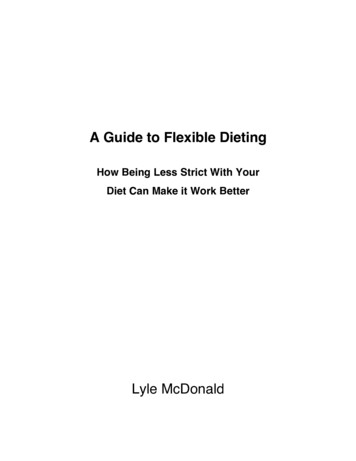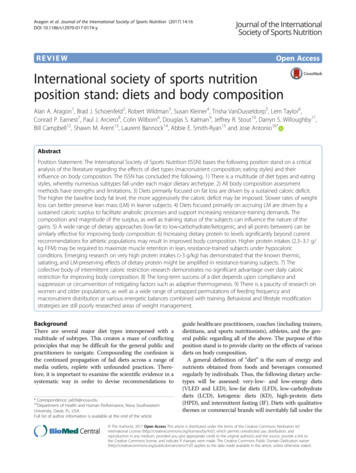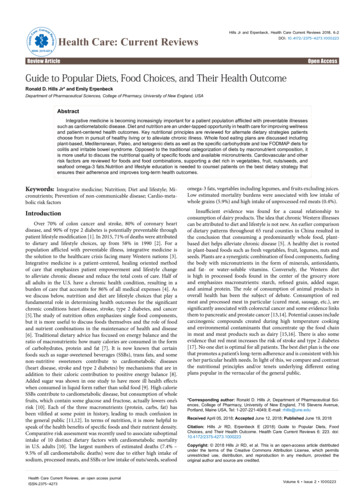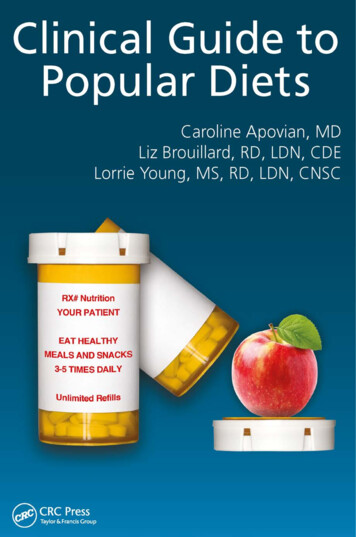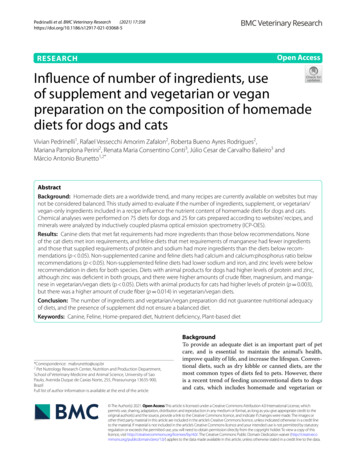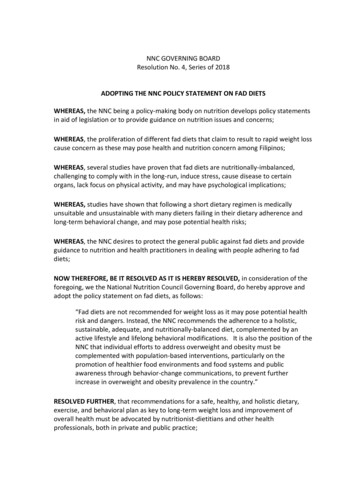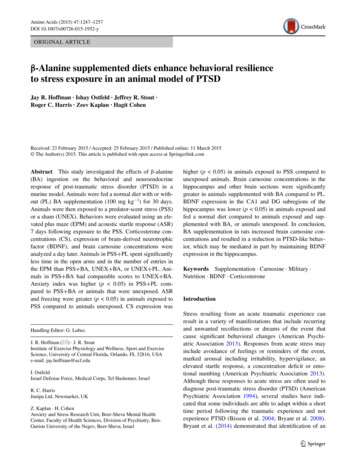
Transcription
Amino Acids (2015) 47:1247–1257DOI 10.1007/s00726-015-1952-yORIGINAL ARTICLEβ‑Alanine supplemented diets enhance behavioral resilienceto stress exposure in an animal model of PTSDJay R. Hoffman · Ishay Ostfeld · Jeffrey R. Stout ·Roger C. Harris · Zeev Kaplan · Hagit CohenReceived: 23 February 2015 / Accepted: 25 February 2015 / Published online: 11 March 2015 The Author(s) 2015. This article is published with open access at Springerlink.comAbstract This study investigated the effects of β-alanine(BA) ingestion on the behavioral and neuroendocrineresponse of post-traumatic stress disorder (PTSD) in amurine model. Animals were fed a normal diet with or without (PL) BA supplementation (100 mg kg 1) for 30 days.Animals were then exposed to a predator-scent stress (PSS)or a sham (UNEX). Behaviors were evaluated using an elevated plus maze (EPM) and acoustic startle response (ASR)7 days following exposure to the PSS. Corticosterone concentrations (CS), expression of brain-derived neurotrophicfactor (BDNF), and brain carnosine concentrations wereanalyzed a day later. Animals in PSS PL spent significantlyless time in the open arms and in the number of entries inthe EPM than PSS BA, UNEX BA, or UNEX PL. Animals in PSS BA had comparable scores to UNEX BA.Anxiety index was higher (p 0.05) in PSS PL compared to PSS BA or animals that were unexposed. ASRand freezing were greater (p 0.05) in animals exposed toPSS compared to animals unexposed. CS expression wasHandling Editor: G. Lubec.J. R. Hoffman (*) · J. R. StoutInstitute of Exercise Physiology and Wellness, Sport and ExerciseScience, University of Central Florida, Orlando, FL 32816, USAe-mail: jay.hoffman@ucf.eduI. OstfeldIsrael Defense Force, Medical Corps, Tel Hashomer, IsraelR. C. HarrisJunipa Ltd, Newmarket, UKZ. Kaplan · H. CohenAnxiety and Stress Research Unit, Beer‑Sheva Mental HealthCenter, Faculty of Health Sciences, Division of Psychiatry, BenGurion University of the Negev, Beer‑Sheva, Israelhigher (p 0.05) in animals exposed to PSS compared tounexposed animals. Brain carnosine concentrations in thehippocampus and other brain sections were significantlygreater in animals supplemented with BA compared to PL.BDNF expression in the CA1 and DG subregions of thehippocampus was lower (p 0.05) in animals exposed andfed a normal diet compared to animals exposed and supplemented with BA, or animals unexposed. In conclusion,BA supplementation in rats increased brain carnosine concentrations and resulted in a reduction in PTSD-like behavior, which may be mediated in part by maintaining BDNFexpression in the hippocampus.Keywords Supplementation · Carnosine · Military ·Nutrition · BDNF · CorticosteroneIntroductionStress resulting from an acute traumatic experience canresult in a variety of manifestations that include recurringand unwanted recollections or dreams of the event thatcause significant behavioral changes (American Psychiatric Association 2013). Responses from acute stress mayinclude avoidance of feelings or reminders of the event,marked arousal including irritability, hypervigilance, anelevated startle response, a concentration deficit or emotional numbing (American Psychiatric Association 2013).Although these responses to acute stress are often used todiagnose post-traumatic stress disorder (PTSD) (AmericanPsychiatric Association 1994), several studies have indicated that some individuals are able to adapt within a shorttime period following the traumatic experience and notexperience PTSD (Bisson et al. 2004; Bryant et al. 2008).Bryant et al. (2014) demonstrated that identification of an13
1248acute stress disorder within the first month of the traumaticexperience appears to be only moderately sensitive (51and 45 % within 3 and 12 months, respectively) for predicting PTSD. However, the absence of acute stress disorder appears to be highly predictive (95 and 94 % within 3and 12 months, respectively) that the individual will notdevelop PTSD (Bryant et al. 2014).The pathophysiology of PTSD is thought to be relatedto changes in the structure of neurons within areas of thebrain that control stress and memory (McEwen 2007). Thehippocampus is one of the most sensitive and adaptableregions of the brain, and many of the changes within thehippocampus occur within the dentate gyrus (DG)–CA3region (McEwen 2007). The DG–CA3 region is thoughtto play a role in the memory of sequences of events, andseveral changes have been suggested to occur in this regionduring stress such as a suppression of neurogenesis or cellsurvival, and a degeneration of dendrites and synapses(McEwen 1999; Sousa et al. 1998; Stewart et al. 2005). Theeffect of stress on brain function though is not limited tothe hippocampus only. The hippocampus works synergistically with the cortex and amygdala to control the processing of emotional memories (Richardson et al. 2004) andreduction of fear (Milad and Quirk 2002). Although themechanism that is stimulating the structural remodeling ofneurons in the brain is quite complex, evidence is compelling that changes in circulating glucocorticoids (McEwen2007; Myers et al. 2014) and expression of brain-derivedneurotrophic factor (BDNF) (Yao et al. 2011) are closelylinked to the plasticity of brain function.Stress has a profound influence on changes in the neuroendocrine system resulting in a significant elevation inglucocorticoids (Myers et al. 2014). Glucocorticoids arereleased from the adrenal gland and cross the blood–brainbarrier to bind to receptors in neurons or glia cells. Glucocorticoid receptors are found in high concentrations withinthe brain, specifically in areas that are related to sites ofstress such as the hippocampus, amygdala, and frontal cortex (Fuxe et al. 1987; Myers et al. 2014). Corticosteroneinjections in the dorsal hippocampus of rodents have beendemonstrated to cause PTSD-like memory impairmentsthat accompany impaired hippocampal function (Kaouaneet al. 2012). Elevations in glucocorticoids are generallyassociated with dendritic remodeling and memory thatoften resemble what is seen during chronic stress (Millerand McEwen 2006). However, the glucocorticoid responseto stress appears to follow an inverted U pattern. Very lowor very high concentrations of circulating glucocorticoidsduring periods of stress are more likely to negatively alterneural plasticity (Miller and McEwen 2006).BDNF is part of the neurotrophin family and hasbeen demonstrated to have an important role in neuronal remodeling and modulating synaptic plasticity and13J. R. Hoffman et al.neurotransmitter release (Castrén and Rantamäki 2010).Angelucci et al. (2014) recently compared BDNF concentrations in individuals diagnosed with PTSD to individualswho were exposed to a traumatic event but not diagnosedwith PTSD. Serum BDNF concentrations were significantly lower in PTSD patients compared to the control subjects. In a rodent model, exposure to stress has been shownto down-regulate BDNF mRNA expression (Kozlovskyet al. 2007). Increasing BDNF expression, or decreasingglucocorticoid levels in individuals who are experiencingstress, may provide increased resiliency to PTSD followingexposure to trauma.Treatment for PTSD is quite varied and generallyinvolves a combination of psychotherapy and pharmacological options that occur following diagnosis (Kirkpatrickand Heller 2014). However, less information is availableregarding potential options for preventing or increasingresiliency to PTSD. Murakami and Furuse (2010) reportedthat a β-alanine supplemented diet in mice was able toincrease brain carnosine concentrations in the cerebralcortex and hypothalamus and increase the concentrationof BDNF in the hippocampus. These changes were alsoaccompanied by significantly greater activity of the micein the open arms of an elevated plus-maze test. Althoughβ-alanine is considered to act as an inhibitory neurotransmitter that can cross the blood–brain barrier (Takeuchi et al.2000), the lack of any significant change in β-alanine concentrations in the cerebral cortex and hypothalamus suggests that the anxiolytic effects observed are likely relatedto an elevation in brain carnosine (β-alanyl-l-histidine)concentrations. This is supported by others demonstratingthat elevated brain carnosine can induce antidepressant-likeactivity (Tomonaga et al. 2004, 2008).In consideration that β-alanine can increase brain carnosine concentrations, which may subsequently induceantidepressant activity, the primary purpose of this studywas to examine the effect of 30 days of β-alanine ingestionon PTSD-like behavioral changes in rodents exposed to apredator-scent stress (PSS). A secondary purpose was toinvestigate the mechanisms underlying the potential beneficial effects of β-alanine ingestion by examining circulatingcorticosterone concentrations and BDNF expression in thehippocampus.MethodsAnimalsAdult male Sprague–Dawley rats weighing 200–250 g(n 122) were habituated to housing conditions for at least7 days. All animals were housed four per cage in a vivarium with stable temperature and a reversed 12-h light/dark
1249β-Alanine supplemented diets enhance behavioral resiliencecycle, with unlimited access to food and water. β-Alaninewas provided with glucomannan in a powder form in an80:20 blend. Rats were provided with 100 mg of the powder per kg of body mass (a total of 30 mg of powder wasdissolved in 25 mL of water). PL-treated rats were provided with the vehicle (glucommanan) at the same relativedose. Animals were handled once daily. All testing was performed during the dark phase in dim red light conditions.This study was performed according to the principles andguidelines of the National Institute of Health Guide forthe Care and Use of Laboratory Animals. All treatmentand testing procedures were approved by the Animal CareCommittee of the Ben-Gurion University of the Negev,Israel.Experimental designRats were randomly assigned to one of four treatmentgroups (n 30 or 31 per group):1. Unexposed and vehicle-treated group (UNEXP PL):rats were fed regular food and water for 30 days andwere exposed to fresh, unused litter for 15 min.2. Unexposed and treated with β-alanine (UNEXP BA):rats were provided β-alanine in their water and wereexposed to fresh, unused litter for 15 min.3. Exposed and vehicle-treated (EXP PL): rats were fedregular food and water for 30 days and were exposed toPSS for 15 min.4. Exposed and treated with β-alanine (EXP BA): ratswere provided β-alanine in their water exposed to PSS.Following the 7-day acclimation period in which allrats received a normal powder diet, they were randomizedinto four groups. Following 30 days of either normal dietor β-alanine supplemented diet the rats were exposed toeither the PSS or sham protocol. All behavioral tests wereconducted 7 days following the PSS or sham protocol, andthe rats were then sacrificed 24 h later and brains wereremoved. Diets were maintained until the end of the study.The validity of this model has been demonstrated in severalstudies (Cohen et al. 2004, 2012b; Kozlovsky et al. 2007).Predator‑scent stress (PSS)Following the 30-day supplementation regimen, animalswere exposed to the PSS protocol. The PSS protocolconsisted of placing the experimental animal on well-soiledcat litter (in use by the cat for 2 days, sifted for stools) for10 min in a closed environment. Control animals wereexposed to fresh, unused litter for the same amount of time.The situational reminder consisted of placing animals onfresh, unused cat litter for 15 min.Assessment scheduleBehavioral responses were assessed in the elevated plusmaze, acoustic startle response, and contextual freezing.All results were recorded and analyzed using an EthoVisionautomated tracking system (Noldus Information Technology, The Netherlands). Performance in the elevated plusmaze and acoustic startle response occurred 7-days following the initial exposure to the PSS. The contextual freezingmeasures were performed on day 8 following initial exposure. The delay in performing these measures from the PSSis based upon findings that extreme behavioral changes,which remain constant after 7 days of exposure and represent ‘chronic symptoms’ (Cohen et al. 2004) which persistover a prolonged duration (Cohen and Zohar 2004; Cohenet al. 2004). Following behavioral assessments, all animalswere killed and their brains removed for analysis.Behavioral measuresElevated plus‑maze (EPM)Behavioral assessments performed in the EPM have previously been described (Cohen et al. 2003, 2012a, b). TheEPM is a plus-shaped platform with two opposing open andtwo opposing closed arms (open only towards the centralplatform and surrounded by 14-cm high opaque walls onthree sides). Rats were placed on the central platform facing an open arm and allowed to explore the maze for 5 min.Each session was videotaped and subsequently scored byan independent observer. Arm entry was defined as entering an arm with all four paws. The following behaviors wereassessed: time spent (duration) in open and closed arms andon the central platform; number of open and closed armentries; and total exploration (entries into all arms). Totalexploration was calculated as the number of entries into anyarm of the maze to distinguish between impaired exploratorybehavior, exploration limited to closed arms (avoidance), andfree exploration. “Anxiety Index”, an index that integratesthe EPM behavioral measures, was calculated as follows: time spent in the open arms number of entries to the open arms total time on the mazetotal exploration on the maze .Anxiety Index 1 213
1250J. R. Hoffman et al.Anxiety Index values range from 0 to 1 where an increasein the index expresses increased anxiety-like behavior.Acoustic startle responseStartle response was measured using two ventilated startlechambers (SR-LAB system, San Diego Instruments, SanDiego, CA). The SR-LAB calibration unit was used routinely to ensure consistent stabilimeter sensitivity betweentest chambers and over time. Each Plexiglas cylinder restson a platform inside a sound-proofed, ventilated chamber.Movement inside the tube is detected by a piezoelectricaccelerometer below the frame. Sound levels within eachtest chamber are measured routinely using a sound levelmeter to ensure consistent presentation. Each test sessionstarted with a 5-min acclimatization period to backgroundwhite noise of 68 dB, followed by 30 acoustic startle trialstimuli in six blocks (110 dB white noise of 40 ms duration with 30 or 45 s inter-trial interval). Behavioral assessment consisted of mean startle amplitude (averaged overall 30 trials) and percent of startle habituation to repeatedpresentation of the acoustic pulse. Percent habituation—thepercent change between the response to the first block ofsound stimuli and the last—was calculated as follows:Measurement of serum corticosteroneSerum corticosterone was measured with ELISA Test Kit(Endocrine Technologies Inc. Newark, CA) according tothe instructions of the manufacturer. Plates were read at450 nm. All reactions were determined in duplicate. Interassay variation was 6.1 % and intra-assay variation 5.9 %.All samples were measured in duplicate. The lowest leveldetectable in this assay is 0.1 ng/mL of serum.Brain BDNF levelsTissue preparationTwenty-four hours following the behavioral tests, tenanimals from each group were deeply anesthetized(ketamine and xylazine mixture) and perfused transcardially with cold 0.9 % physiological saline followed by4 % paraformaldehyde (Sigma-Aldrich) in 0.1 M phosphate buffer (pH 7.4). Brains were quickly removed,postfixed in the same fixative for 12 h at 4 C, and cryoprotected overnight in 30 % sucrose in 0.1 M phosphatebuffer at 4 C. Brains were frozen on dry ice and storedat 80 C. Serial coronal sections (10 µm) at the level(average startle amplitude in Block 1) (average startle amplitude in Block 6).Percent Habituation 100 average startle amplitude in Block 1Contextual freezing measurementFreezing behavior was scored during the situationalreminder/cue exposure and was defined as an absence ofall movement (except for respiration) (Kim et al. 1992).Total cumulative freezing time (total seconds spent freezing during each assessment period) was measured and calculated as a percentage of total time. Freezing behavior wasrecorded using an overhead video camera and scored forimmobility using the recorded images. The videotape andthe recorded images were both scored by a trained observerunaware of the treatment conditions.Blood samplingTwenty rats from each group were decapitated with a guillotine. Care was taken to minimize situational stress: thearea was thoroughly cleaned between each killing and bodies were removed. Trunk blood was collected and left atroom temperature for 2 h and then centrifuged (1000g for10 min at 4 C) with a Hermle centrifuge. Serum (approximately 1 mL from each rat) was collected and stored at 80 C until the analysis was performed.13of dorsal hippocampus were collected for each animal, using a cryostat (Leica CM 1850) and mounted oncoated slides.ImmunofluorescenceSliced sections were air dried and incubated in frozen methanol (2 min) and in 4 % Para-formal-aldehyde(4 min). After three washes in phosphate-buffered saline(PBS) containing Tween 20 (PBS/T) (Sigma-Aldrich), thesections were incubated for 60 min in a blocking solutionin normal goat or horse serum in PBS and then overnightat 4 C with the primary antibodies against BDNF (1:250each; Abcam). After three washes in PBS/T, sections wereincubated in DyLight-488 in PBS containing 2 % normal serum for 2 h. Sections were washed and mountedwith mounting medium (Vectrastain Vector laboratories,USA). Control staining was performed in the absence ofthe primary antibodies. Additionally, secondary fluorescent labels were swapped to check cross-reactivity andsections were incubated without any primary antibodiesto check for any non-specific binding of the secondaryantibodies.
1251β-Alanine supplemented diets enhance behavioral resilienceQuantificationA computer-assisted image analysis system (Leica Application Suite V3.6, Leica, Germany) was used for quantitative analysis of the immunostaining and 50 objectivelens was employed to assess the number of BDNF-IRpositive cells in the hippocampus, divided into three(counted separately) areas: CA1 subfield, CA3 subfield,and dentate gyrus (DG). The regions of interest were outlined and computer-aided estimation was used to calculatethe number of BDNF-IR cells in the pyramidal layer ofCA1 and CA3, and in the granular layer of the DG. Sevenrepresentative sections of the hippocampus were chosen(between Bregma 2.30 and Bregma 3.60) from eachanimal, from each group. The sections were analyzed bytwo observers blinded to the treatment protocol. Standardtechnique was used to estimate the number of BDNF cellprofiles per unit area for each investigated hippocampalstructure.Measurement of brain carnosine concentrationsCarnosine concentrations in brain homogenates were determined by Liquid Chromatographic/tandem mass spectrometric (LC/MS/MS) analysis according to previously published methods (Aldini et al. 2004). Brains were partiallythawed on ice and six brain regions were sampled: cerebralcortex, hypothalamus, hippocampus, amygdala, olfactorybulb, and thalamus. Each sample was weighed and transferred into individual vials for further homogenization.Brain samples were homogenized in saline (0.9 %NaCl; 100 mg mL 1) supplemented with 1 mM EDTA,using Polytron Homogenizer. Homogenates were storedat 20 5 C prior to LC/MS/MS analysis. Homogenates were spiked with Internal Standard (D3-L-Dopa) andde-proteinized by addition of 100 μL of 700 mM PCA to250 µL sample. After 1 min of Vortex, samples were centrifuged at 13,200 RPM [15.7 Relative Centrifugal Force(RCF)] for 12 min. The supernatant was diluted with100 µL of Mobile phase and injected. L-Carnosine purchased from Sigma was used to prepare standards for thecalibration curve (in ppb). Samples were diluted 5 priorto analysis. The concentration read from the standard curvewas multiplied by the dilution factor and converted to ppmunits.Statistical analysesThe statistical analyses were performed using a one-wayanalysis of variance (ANOVA). In the event of a significantF ratio, LSD post hoc analysis was used for pairwise comparisons. All data are reported as mean SD. Pearson’sproduct-moment correlation was used to determine selectedbivariate correlations. An alpha level of p 0.05 was usedto determine statistical significance. Data were analyzedusing SPSS v22 software (SPSS Inc., Chicago, IL).ResultsElevated plus‑mazeComparisons between the groups for time spent in openarms indicated a significant effect (F (3, 118) 7.06,p 0.001). Post-hoc analyses indicated that animals thatconsumed a normal diet and were exposed to PSS spentsignificantly less time in the open arms than all other treatment groups (p value ranging from 0.001 to 0.012). Noother between-group differences were noted in time spentin open arms (see Fig. 1a). Comparisons of open armentries (see Fig. 1b) also showed a significant interactionbetween groups (F (3, 118) 9.55, p 0.001). Normaldiet fed animals that were exposed to PSS exhibited significantly (p value 0.001) fewer entries than all other treatment groups. (p value 0.001). No other group differenceswere noted in open arm entries.Analysis of the total activity on the EPM of all groups(see Fig. 1c) revealed no significant differences betweenthe groups (F (3, 118) 0.925, p 0.431). Based uponthe integrated behavioral measures a significant differencein the anxiety-index was noted between the groups (seeFig. 1d) (F (3, 118) 8.05, p 0.001). Animals fed a normal diet and exposed to PSS exhibited significantly greateranxiety (p value ranging from 0.001–0.002) than othertreatment groups (see Fig. 1d). No other between-groupeffects were noted.Acute startle response and startle habituationComparisons between the groups in acoustic startleamplitude revealed a significant group difference (F (3,118) 14.02, p 0.001) (see Fig. 2a). Startle amplitudewas significantly greater for animals that were exposed toPSS and fed a normal diet compared to unexposed animals,regardless of diet (p value 0.001), as well as for animalsexposed to PSS and fed BA compared to unexposed animals fed a normal diet (p 0.001) or supplemented withBA (p 0.0001). In addition, animals that were exposed toPSS and whose diets were supplemented with BA tendedto have a lower startle amplitude than exposed animalsthat were not fed BA (p 0.085). A significant differencewas also noted in startle habituation (F (3, 118) 9.11,p 0.001) (see Fig. 2b). Animals exposed to PSS regardless of diet had a significantly lower habituation score thanall other groups (p value 0.001). No other significant differences between groups were noted.13
1252J. R. Hoffman et al.Fig. 1 Behavioral performance in elevated plus-maze. a Comparison between the groups for time spent in open arms; b comparisonbetween the groups in the number of open arm entries; c comparison between the groups in the total activity; d comparison betweenthe groups in the anxiety-index; a significantly different thanUNEX PL, b significantly different than UNEX BA, d significantlydifferent than PSS BA, UNEX PL animals that were not exposed tothe predator scent stress and fed a normal diet, UNEX BA animalsthat were not exposed to the predator scent stress and supplementedwith β-alanine, PSS PL animals that were exposed to the predator scent stress and fed a normal diet, PSS BA animals that wereexposed to the predator scent stress and supplemented with β-alanine.All data reported as mean SDFig. 2 Acoustic Startle Response. a Comparisons between thegroups in startle amplitude; b comparisons between the groups instartle habituation; a significantly different than UNEX PL, b significantly different than UNEX BA, UNEX PL animals that were notexposed to the predator scent stress and fed a normal diet, UNEX BAanimals that were not exposed to the predator scent stress and supplemented with β-alanine, PSS PL animals that were exposed tothe predator scent stress and fed a normal diet, PSS BA animalsthat were exposed to the predator scent stress and supplemented withβ-alanine. All data reported as mean SD13
1253β-Alanine supplemented diets enhance behavioral resilienceFig. 3 Freezing Behavior upon Cue-Exposure. a significantly different than UNEX PL, b significantly different than UNEX BA,UNEX PL animals that were not exposed to the predator scent stressand fed a normal diet, UNEX BA animals that were not exposed tothe predator scent stress and supplemented with β-alanine, PSS PLanimals that were exposed to the predator scent stress and fed anormal diet, PSS BA animals that were exposed to the predatorscent stress and supplemented with β-alanine. All data reported asmean SDFig. 4 Corticosterone Concentrations on Day-8 Post-PSS Exposure.a significantly different than UNEX PL, b significantly differentthan UNEX BA, UNEX PL animals that were not exposed to thepredator scent stress and fed a normal diet, UNEX BA animals thatwere not exposed to the predator scent stress and supplemented withβ-alanine, PSS PL animals that were exposed to the predator scentstress and fed a normal diet, PSS BA animals that were exposed tothe predator scent stress and supplemented with β-alanine. All datareported as mean SDEffect of cue‑exposure on freezing behavior at day 8rats fed a normal diet compared to exposed rats supplemented with BA.Figure 3 depicts the freezing behavior upon cue-exposure.A significant difference between the groups was seen infreezing behavior (F (3118) 9.342, p 0.001). Animalsexposed to PSS and fed a normal diet had significantlygreater immobility upon cue than animals that were unexposed and fed a normal diet (p 0.001) or fed a diet supplemented with BA (p 0.001). Animals exposed to PSSand supplemented with BA were also observed to havesignificantly greater immobility upon cue than animals thatwere unexposed and fed a normal diet (p 0.01) or fed adiet supplemented with BA (p 0.003). Animals exposedto PSS and fed BA froze approximately 6 % less (40.9 %versus 34.8 %) less than animals exposed to PSS and fed anormal diet. However, this difference was not statisticallydifferent (p 0.148).Corticosterone concentrations at day 8 post‑PSS exposureA significant difference between the groups (Fig. 4)was observed in corticosterone concentrations (F (3,76) 13.883, p 0.001). Corticosterone concentrations inanimals exposed to PSS and fed a normal diet were significantly greater than animals not exposed and fed a similardiet (p 0.001) or supplemented with BA (p 0.001). Inaddition, animals that were exposed to PSS and supplemented with BA were also observed to have significantlyhigher corticosterone concentrations than animals that wereunexposed and fed a normal diet (p 0.001) or were unexposed and supplemented with BA (p 0.001). No significant differences (p 0.837) were noted between exposedBDNF expression on day‑8 post‑PSS exposureComparisons between the groups in BDNF expressionin the CA1, CA3, and DG subregions can be observed inFig. 5a–c, respectively. Significant differences were notedin the CA1 (F (3, 36) 23.2, p 0.001) and DG subregions (F (1, 36) 4.126, p 0.013). No differences wereobserved between the groups in the CA3 subregion (F (1,36) 0.918, p 0.442). BDNF expression in the CA1 andDG subregions in the animals that were exposed to PSSand fed a normal diet was significantly lower than that inall other groups (p values ranging from 0.001–0.011). Inaddition, BDNF expression in animals exposed to PSS andsupplemented with BA was significantly lower than that inunexposed animals (r values ranging from 0.009–0.024),but significantly greater than that in exposed rats fed a normal diet in the CA1 (p 0.001) only. In the DG subregion,BDNF expression in animals exposed to PSS but supplemented with BA were not statistically different from animals not exposed and either fed a normal diet (p 0.765)or supplemented with BA (p 0.818); however, theexpression of BDNF in these animals exposed and fed BAwas greater (p 0.011) than that in animals exposed andfed a normal diet. No other differences were noted.Brain carnosine concentrations on day 8 post‑PSS exposureThe concentration of carnosine in various areas of thebrain can be observed in Table 1. Significant differences13
1254J. R. Hoffman et al.Fig. 5 BDNF Expression on Day-8 Post-PSS Exposure. BDNFexpression in the CA1 (a), CA3 (b) and DG (c) subregions. a significantly different than UNEX PL, b significantly different thanUNEX BA, c significantly different than PSS PL, d significantlydifferent than PSS BA, UNEX PL animals that were not exposedto the predator scent stress and fed a normal diet, UNEX BA animalsthat were not exposed to the predator scent stress and supplementedwith β-alanine, PSS PL animals that were exposed to the predator scent stress and fed a normal diet, PSS BA animals that wereexposed to the predator scent stress and supplemented with β-alanine.All data reported as mean SDTable 1 Brain carnosine concentrations (mg L 1)UNEX PLUNEX BAPSS PLPSS BAHippocampusCortexHypothalamusAmygdalaOlfactory bulbThalamus0.71 0.593.75 3.98a1.12 0.900.76 0.793.78 4.47a0.96 0.430.64 0.642.60 2.850.78 0.460.30 0.342.34 3.040.55 0.5011,011 39108309 68875744 64910.77 0.463.99 5.10a1.16 0.705.58 4.39a, b6.55 4.90a, b4.54 4.04a, b3.52 3.84a, b13,109 97735.97 4.48a, bAll data reported as mean SD UNEX PL animals that were not exposed to the predator scent stress and fed a normal diet, UNEX BA animals that were not exposed to the predator scent stress and supplemented with β-alanine, PSS PL animals that were exposed to the predatorscent stress and fed a normal diet
Science, University of Central Florida, Orlando, FL 32816, USA e-mail: jay.hoffman@ucf.edu I. Ostfeld Israel Defense Force, Medical Corps, Tel Hashomer, Israel R. C. Harris Junipa Ltd, Newmarket, UK Z. Kaplan · H. Cohen Anxiety and Stress Research Unit, Beer-Sheva Mental Health Center, Faculty of Health Sciences, Division of Psychiatry, Ben-
